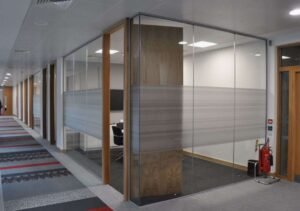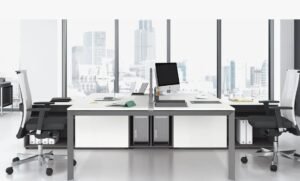The concept of workspace design is evolving rapidly, and as we step into the heart of 2025, office environments are transforming more than ever before. At the center of this transformation lies a crucial component—Office furnitures 2025. These are not just desks and chairs anymore; they are smart, adaptive, ergonomic, and designed to enhance both productivity and well-being. The workplace of the future blends aesthetics with function, where office furniture plays a pivotal role in shaping company culture and improving employee experience. Businesses are now prioritizing wellness, collaboration, and flexibility, and office furniture trends reflect this shift in values. Gone are the days of one-size-fits-all cubicles. Now, companies are investing in customized office setups that promote a dynamic and healthy working atmosphere. With hybrid and remote work becoming more normalized, the demand for versatile and innovative furniture solutions is also on the rise.
Importance of Ergonomics in Office Furnitures 2025
One of the most dominant trends in office furnitures 2025 is the focus on ergonomics. Employers understand that uncomfortable or poorly designed furniture can lead to long-term health issues and a decline in productivity. As a result, ergonomic furniture is not a luxury anymore—it’s a necessity. Sit-stand desks, ergonomic office chairs with lumbar support, and adjustable monitor stands are becoming standard items in modern offices. These pieces not only help maintain proper posture but also reduce physical fatigue and musculoskeletal problems. Employees are encouraged to shift positions throughout the day, and furniture is supporting that movement with built-in flexibility. Even small accessories like footrests, anti-fatigue mats, and wrist supports are contributing to more comfortable working environments. Companies that invest in ergonomic office furniture are seeing increased employee satisfaction, lower absenteeism, and higher engagement rates.
Smart Furniture and Technology Integration
The next level of innovation in office furnitures 2025 is smart furniture that integrates seamlessly with technology. This includes desks with built-in charging ports, wireless charging pads, and even IoT-enabled furniture that tracks usage patterns and encourages healthier working habits. Imagine a desk that reminds you when to take a break or a chair that adjusts automatically based on your sitting posture. These smart elements are not futuristic dreams—they are becoming part of today’s workplace reality. Conference tables with embedded screens and cable management systems, storage units with smart locks, and acoustic panels with noise-canceling capabilities are enhancing both collaboration and privacy. In 2025, office furniture will not just support work—it will actively improve it.
Sustainability and Eco-Friendly Materials
Another major focus of office furnitures 2025 is sustainability. Companies are becoming more conscious of their environmental impact, and office furniture manufacturers are responding with greener solutions. Recycled materials, biodegradable plastics, low-VOC finishes, and sustainably sourced wood are now being used widely in furniture production. Moreover, modular designs allow for easy repair and reconfiguration, which extends the life of the furniture and reduces waste. Office furniture is also being designed to be disassembled and recycled at the end of its lifecycle. Many brands are adopting circular economy principles, offering take-back programs and refurbishing services. Not only does sustainable furniture reduce the carbon footprint, but it also aligns with corporate social responsibility goals and appeals to environmentally aware employees and clients.
Aesthetic Designs for a Positive Work Culture
Design plays a significant role in workplace satisfaction, and office furnitures 2025 are crafted with aesthetics in mind. Sleek lines, minimalist forms, natural finishes, and vibrant accents are creating inspiring environments. From collaborative lounges to focused work pods, every piece of furniture is selected to match the brand identity and company values. The modern office isn’t just about functionality—it’s about creating an atmosphere that motivates and inspires. Color psychology is also being taken into account, with calming hues like greens and blues being used to reduce stress, and energetic tones like yellow and orange boosting creativity. Design-forward offices attract talent and foster a stronger company culture. In 2025, office furniture isn’t just what employees use—it’s part of what defines how they feel at work.
Flexibility and Modularity in Modern Offices
Flexibility is at the heart of workspace innovation in 2025, and office furnitures 2025 reflect this demand for changeable and scalable designs. Modular furniture systems allow for quick reconfiguration to adapt to different tasks and team sizes. Whether it’s movable walls, mobile desks, foldable tables, or nesting chairs, every component supports a dynamic workflow. With the rise of agile working methods and multi-functional spaces, businesses require furniture that can be easily customized without major disruptions. Office layouts are no longer fixed—they’re fluid. This flexibility enhances creativity, collaboration, and operational efficiency. Employees are also being given more control over their personal workspace, whether it’s selecting the height of their desk or choosing a preferred type of seating. The modular movement is all about empowering people through choice and adaptability.
Wellness-Centric Design and Biophilic Elements
One of the newer trends shaping office furnitures 2025 is the focus on wellness and mental health. Biophilic design principles are being incorporated into furniture by integrating natural materials, organic shapes, and greenery into the workspace. Furniture with built-in planters, desks made of reclaimed wood, and acoustic panels resembling natural textures are becoming popular. These elements contribute to reduced stress, enhanced mood, and improved focus. Relaxation zones with soft seating, meditation pods, and privacy booths are becoming essential parts of office design, promoting mental health and preventing burnout. Furniture in 2025 is going beyond physical support—it’s helping employees feel emotionally connected and mentally rejuvenated. Creating such human-centered spaces results in happier and more productive teams.
Conclusion: The Future of Work Begins with Office Furnitures 2025
As the nature of work continues to evolve, so does the need for innovative and human-centric design in our workspaces. Office furnitures 2025 are at the forefront of this change, redefining what it means to work comfortably, efficiently, and sustainably. From ergonomic seating to smart desks and eco-friendly materials, the furniture of the future is smarter, greener, and more flexible. Companies that embrace these changes are not just investing in furniture—they are investing in their people, culture, and long-term success. The office is no longer just a place to work—it’s an experience, and the right furniture makes all the difference.






